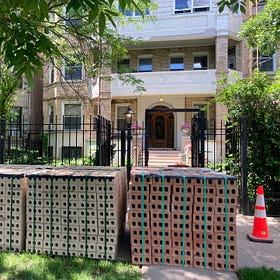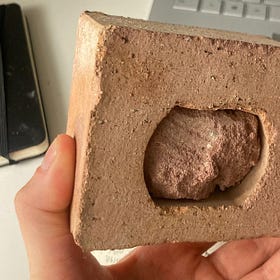Waves slapping the rocks, climbing along the edge of the shoreline in the pouring rain, I spotted them in a sandy patch, waiting, resting. They were soft and rounded, laying together like two friends telling secrets. There is something to me so supremely perfect about these objects.
Every day we see bricks pressed tightly into buildings, glued to one another with mortar. For centuries they stand still, activated in the sense that they’re doing what they ought to, but repressed in the sense that they are stuck. To come upon these bricks was like seeing your principal after they retired, out dancing with no inhibitions. Feels sort of wrong, but mostly you’re happy for them, understand that they deserve it, that they’re living and flourishing in this world. It was liberating to see these bricks loose, astray on the shore, softened into a shape that guarantee they can never be part of a building again. Officially retired. They have left their cycle of utility, and now are just resting, beautiful in their dissolution.
The tones (and thus materiality) of the clay composing the two bricks differ, suggesting they were sourced from different locations. The difference in design (extrusions) suggest they were also probably used in separate projects. They met neither in birth nor work-life. When they were relieved of their duties to hold a building, they both found their way to the lake—where all good bricks retire. Maybe they met in the water, laying on the lake’s bottom, feeling the weight of the water press onto them, comfortable after missing the building’s weight for all those years. It was really soothing, softer than chalky mortar, rough on their backs. No, the water washed them, permeated them and made them feel soggy, laden with memories. So they shared stories of all the buildings they’ve been in, how many cities they’ve seen. Fish swam by them and through them, tides changed, waters froze and unfroze. The wilder, wavier days of spring would pick them up and shift them around, and soon enough they were both spit out to shore. First one, then the next. Rejected. Together they watched the waves roll in, they sighed together. Then on a stormy day this July, a girl with a blanket on her head saw their loving gaze and walked smiling up the muddy hill with one in each hand. Now they are admired and written about for a blog that has no good reason to be here, except for this girl to exude her reverence for inanimate objects, among other things.
I love these bricks because they are at once soft and rigid, they teach me that hard things too are susceptible to motion and change. Even if something seems fixed it can wear away— even if something seems difficult, it too will soften.
Thanks for reading my love note.
If you want to read more about bricks, or rather, me + bricks, see below:
Ideal Objects
Hello sweet readers, This week I published two essays that I wrote in spring of 2022 and revisited recently: about the lesson within an extruded brick, Core Hole, and an apartment building called The Ideal. Over the past few months, I have been collecting found bricks, specifically the extruded brick.
Core Hole
You are a brick sitting sitting in a pile of rubble, destruction of a building long gone. You are unattached, feeling aimless, pointless — what is the point of you without the context of others? Do you matter? You are alone, you are unbuilt.
Treasured Object
I peeled this brick off of a building crumbling down, under reconstruction a half mile from my house. Typical of a Chicago Common Brick, it is inconsistent in color and texture—ranging from the yellow of an early summer peach to the gummy pink of a Tyconderoga eraser head.
Roman Brick
A month ago, I was in Rome. The architectural history there is so so rich, but I want to focus on the smallest item, the elemental object that makes up these longstanding ruins: the Roman brick.








Pretty magical